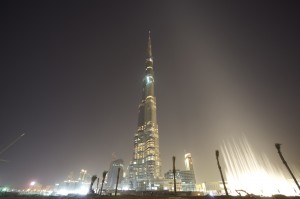By John Defterios (CNN in KT) www.khaleeejtimes.ae
The gleaming tower is impressive from any angle, with the searing autumn sun bouncing off the mirrored glass and stainless steel. We know that the Burj Dubai will be the highest building in the world when it opens at over 800 meters, but the final height is being kept secret.

The targeted completion date was also a closely guarded secret until I sat down with the Chairman of Emaar, Mohamed Alabar who confidently said in his executive suite that he is “shooting for (UAE) National Day” and that the December 2nd goal was achievable. His team, including his CEO of the hospitality unit, seemed surprised by that statement, which sets the bar high after a half year of delays.
Surrounding the Burj Dubai is another landmark in a destination that has built its reputation on iconic buildings and development projects – The Palm, The World and the sail-like structure the Burj Al Arab. Alabar invited me on an early evening tour of The Fountain, which is the biggest of its kind in the world. The jets can reach a height of 50 stories with a cost of more than $250 million to install.
The entire downtown complex is impressive and he beams with youth-like enthusiasm, with the giant Dubai Mall and The Address hotel all in the same complex. Alabar thought it was important to deliver the project after the global downturn, which rattled the desert foundations of Dubai.
The interview with the Emaar Chairman came during the eighth year of Cityscape, the property exhibition where developers in years gone by would launch multi-billion dollars projects and spend millions of dollars on model displays and stands. This year the atmosphere was far more subdued and sober. Developers talked of completion dates and deliveries, not size and new products.
Alabar, arguably the largest developer in a region that throws lots of” biggest” titles around, was reflective of what transpired over the last year and where we are today.
“We’ve learned the art of managing business which has changed forever in my opinion. I thought I was conservative. I think I could have been more conservative,” adding, “I am much harsher in the operation now.” Alabar could not address issues regarding the proposed merger between his group and the property development entities of Dubai Holdings, but he did not shy away from some of the more sensitive topics on the table these days, such as Dubai’s debt.
On where demand would come from for the second tranche of the $20 billion bond offering, he said the “majority from the (UAE) government with some private sector.” Asked whether a total estimated debt of $59 billion dollars could be serviced between now and the end of 2012, he said, “Between repayment and restructuring over the next three, four, five years, I really don’t see an issue there.”
When digging through the analyst reports, it seems a disproportionate amount of that debt sits within the empire of Dubai World and its property group Nakheel. It is weighing heavily on the Emirate overall. Dubai is eager to move on from a 40-50 per cent property price drop over the past year.
Questions remain on how certain entities will contend with that debt burden. When asked whether a major cleaning up was required, he was diplomatic and frank at the same time, “I think restructuring in all businesses is a must.
We cannot do business the way we used to do. I have restructured my business and I am sure DP World is restructuring their business the way Mercedes Benz is restructuring its business. So the answer is yes.”
Alabar like other executives is confident that Dubai’s position as a financial services and trade hub, with a more advanced infrastructure than its neighbours will allow for a faster recovery and a resumption of foreign direct investment. He singled out higher traffic numbers already for Emirates Airlines and the return of expatriate white-collar workers. Our discussion took place while the IMF-World Bank meetings were underway in Istanbul. The two organisations put out similar growth projections of between two and two-and-a-half per cent for the UAE next year. The master developer thought that number is too conservative.
The days of double-digit growth are not coming back soon, but a figure about double that is what he has in mind for 2010.
We also talked about the “new normal” — a new term to describe the post-downturn economy. The developed world is bracing for much slower growth for the next five years as a result of record debt levels. Many in the region are adapting to a different reality, even as they get ready to deliver on the next “biggest thing.”












